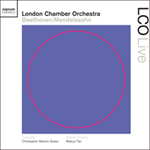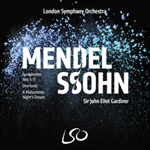
Welcome to Hyperion Records, a British classical label devoted to presenting high-quality recordings of music of all styles and from all periods from the twelfth century to the twenty-first.
Hyperion offers both CDs, and downloads in a number of formats. The site is also available in several languages.
Please use the dropdown buttons to set your preferred options, or use the checkbox to accept the defaults.

| London Chamber Orchestra, Christopher Warren-Green (conductor)» More |
 PERFORMANCE
PERFORMANCE RECORDING
RECORDINGMendelssohn’s thorough-going but liberal education is everywhere evident in this symphony. Just as the first movement translates his painter’s eye into musical light and shade, his literary accomplishments lend the second its gravitas. His letters and drawings while on tour attest to his awe at finally laying eyes upon the ruins of Rome’s imperial glory, after his years as an avid classical scholar. His account of the Holy Week processions through Rome also fits the steady, sombre tread of the theme in the bass. Two flutes wind their way around each other at one point like trails of incense, before dissonant clarinets add a sharper tang to the harmony. There may also be a personal inspiration in the form of a memorial to his childhood composition teacher Carl Friedrich Zelter, who died in 1832, before Mendelssohn revised the symphony for publication.
If anything it is the third movement which performs more of the traditional functions of a slow movement, though the minuet flows easily enough. The brightness of its soundworld is partly due to the (relatively rare for the time) ‘high’ key of A major, which the symphony shares with Mozart’s 29th—and more importantly with Beethoven’s Seventh. Beethoven’s work seems to have provided Mendelssohn a structural template for the ‘Italian’ Symphony, and the furious, danceinspired finale is only the most obvious correspondence. Saltarello does not imply a specific dance metre in its own right—it comes from the Latin saltare, meaning simply to dance—but Mendelssohn seems to have associated it with the wild and whirling tarantella of Naples. Taken at a true presto, the music seems to hang on for dear life—or for grim death. There is no resolution here, for the movement stays in the minor key until its final brusque send-off. As so often, Mendelssohn’s reputation for geniality is belied by a tension that here brilliantly reflects the intensity of Mediterranean life.
from notes by Peter Quantrill © 2010
À l’instar de Berlioz, qui se trouvait à Rome au même moment, Mendelssohn voyait peu de motifs d’admiration dans la musique italienne contemporaine: «Pourquoi l’Italie insiste-t-elle tant sur le fait qu’elle est le pays de l’Art», écrivitil à sa famille, «alors que c’est en fait le pays de la Nature, une nature qui enchante chaque cœur? La musique n’y manque pas: elle résonne et vibre de toute part.» C’est le flot d’énergie de la Nature qui semble propulser les premières mesures, avec cette pulsation rapide d’accords de vents et cette ligne de violon s’élevant avec une vigueur et une grâce toutes italiennes. Cet élan perdure à travers tout le premier mouvement; le second thème (aux clarinettes et bassons) est plus suave, mais il repose sur la même formule rythmique. La section centrale de développement introduit une nouvelle mélodie enlevée aux violons, sur laquelle est bâtie la progression vers le sommet d’intensité; cette mélodie reviendra plus tard, après la réexposition des deux précédents thèmes.
La marche solennelle constituant le second mouvement aurait été inspirée par la vue d’une procession religieuse (Berlioz inclurait pareillement une «Marche de pèlerins» dans son Harold en Italie, composé quatre ans plus tard). L’évocation de Mendelssohn consiste en une mélodie austère aux couleurs envoûtantes sur un accompagnement moelleux de cordes, mais elle est interrompue par deux épisodes d’une musique plus chaleureuse, plus pastorale, comme si l’observateur était momentanément distrait par la beauté du paysage. À chaque fois, les pèlerins regagnent toutefois son attention, et le mouvement se conclut tandis qu’ils disparaissent au loin.
Le troisième mouvement est un menuet de facture classique, même s’il n’est pas désigné comme tel, même si plane sur lui un sentiment de nostalgie mélancolique teinté de romantisme et si les tendres appels de cors de sa calme section centrale rappellent l’univers sylvestre magique de la musique de scène que Mendelssohn composa pour Le Songe d’une nuit d’été.
La musique italienne finit par laisser son empreinte sur le finale, bien que ce ne soit pas l’esprit de Rossini ou de Bellini qui y préside mais plutôt celui d’une danse populaire, la saltarelle. Durant l’été 1831, Mendelssohn s’était installé à Naples, et c’est là qu’il découvrit cette vigoureuse danse sautée.
La réinterprétation symphonique qu’il en offre est germanique, à n’en point douter—en témoigne la longue incursion, à mi-parcours, d’un contrepoint désinvolte; mais, fougueuse et menée d’une main de fer, elle assure à cette célébration de la vie et de la lumière italiennes la conclusion grisante que l’on attendait.
extrait des notes rédigées par Lindsay Kemp © 2016
Français: Claire Delamarche
Wie Berlioz, der sich zur gleichen Zeit in Rom aufhielt, sah Mendelssohn wenig Bewundernswertes in der damaligen zeitgenössischen italienischen Musik. „Warum soll auch Italien heut zu Tage mit Gewalt ein Land der Kunst sein, während es das Land der Natur ist, und dadurch Alles beglückt!“ „Kein Mangel an Musik hier; es hallt und schallt an allen Seiten.“ (Übersetzung des letzten Zitats aus dem Englischen, d. Ü.) Sicherlich bekommt man den Eindruck, als sei gleich der Beginn der Sinfonie von der unbändigen Energie der Natur erfüllt. Eindrucksvoll kurbeln dabei die pulsierenden Holzbläserakkorde und eine aufsteigende Violinlinie von italienischer Sportlichkeit und Anmut das Geschehen an. Dieser Elan wird im gesamten ersten Satz beibehalten. Ein zweites Thema (von den Klarinetten und Fagotten vorgestellt) ist weicher, aber vom gleichen rhythmischen Schlag. Der zentrale Durchführungsabschnitt präsentiert eine flotte neue Melodie in den Violinen, mit deren Hilfe ein Höhepunkt angesteuert wird. Diese Melodie kehrt nach der Reprise der Anfangsthemen wieder zurück.
Man sagt, der feierliche Marsch des zweiten Satzes sei von dem Anblick einer religiösen Prozession angeregt worden (Berlioz fügte einen ähnlichen Marsch („Marsch der Pilger“) in seinen vier Jahre später komponierten Harold in Italien ein). Mendelssohns Darstellung besteht aus einer kargen und unheimlich anmutenden Melodie über einer weich polsternden Streicherbegleitung. Jedoch gibt es auch zwei Episoden mit wärmerer, ländlicherer Musik, als ob der Zuschauer für einen Moment durch die Schönheit der Landschaften abgelenkt wird. Beide Male ziehen die Pilger aber wieder die Aufmerksamkeit auf sich zurück, und der Satz endet mit dem Verschwinden des Umzugs in der Ferne.
Der dritte Satz ist ein klassisches Menuett, auch wenn er nicht diesen Namen trägt und eher ein romantisch gefärbtes Gefühl wehmütiger Nostalgie verbreitet. Der Satz enthält einen Mittelteil, dessen sanfte Hornrufe die Welt des Zauberwalds aus Mendelssohns eigener Musik zum Sommernachtstraum beschwört.
Im Schlusssatz hört man endlich auch italienische Musik. Aber hier herrscht nicht das Genie eines Rossinis oder Bellinis, sondern der Volkstanz mit Namen Saltarello. Im Sommer 1831 war Mendelssohn mittlerweile nach Neapel gezogen, wo er diesen energischen Sprungtanz erlebte. Mendelssohns sinfonische Version hat natürlich einen germanischen Charakter—man braucht sich in der Satzmitte nur die lange Abschweifung mit dem sich gelassen gebenden Kontrapunkt anzuschauen. Aber Mendelssohns Saltarello ist schwungvoll und energisch und liefert so einen ausreichend berauschenden Abschluss zu diesem Fest des italienischen Lebens und Lichtes.
aus dem Begleittext von Lindsay Kemp © 2016
Deutsch: Elke Hockings
 Beethoven & Mendelssohn: LCO Live Beethoven & Mendelssohn: LCO LiveThe London Chamber Orchestra, the UK’s oldest chamber orchestra, has nurtured the new and paid homage to the traditional since 1921. Since 1988 Principal Conductor and Music Director Christopher Warren-Green has brought together the inspirational ...» More |
 Mendelssohn: Symphonies & Overtures Mendelssohn: Symphonies & OverturesLSO Live presents Sir John Eliot Gardiner’s award-winning Mendelssohn series together in its entirety for the first time. Captured over three seasons during critically acclaimed concerts in the Barbican Hall, this set offers listeners the definiti ...» More |

